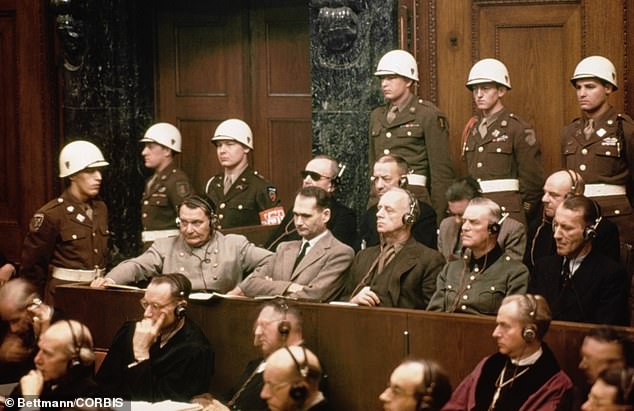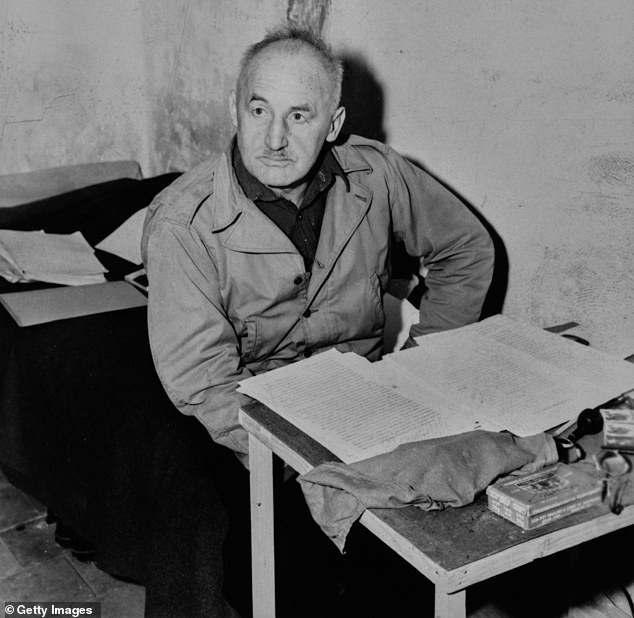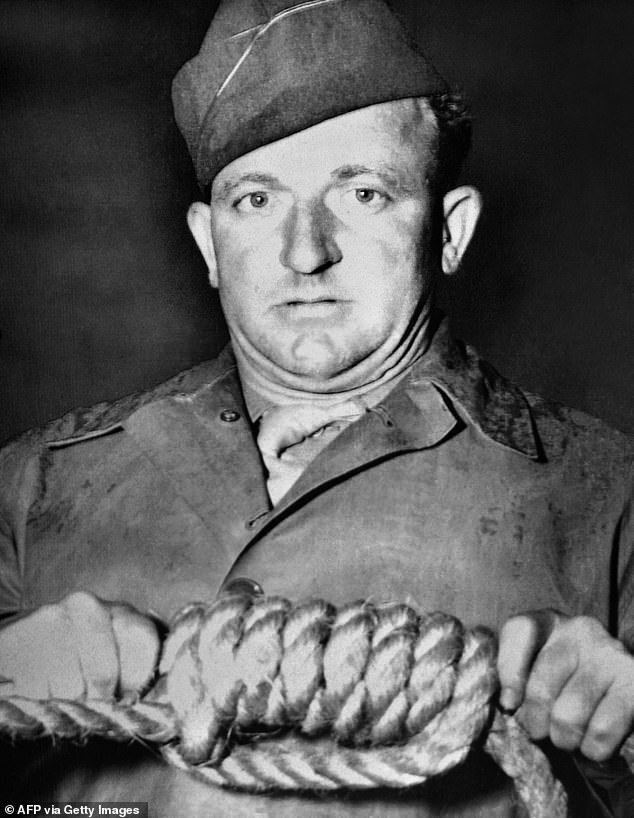When death came it was grisly and undignified. As Hitler’s henchmen, the ten condemned men had wielded enormous power.
Yet they died like common criminals, twitching on the end of a rope, sent from this world by a ham-fisted hangman whose ineptitude ensured that for some the end was horrible and slow.
At one point the American executioner Master Sergeant John C. Woods had to duck beneath the scaffold to finish off the Nazis’ jewbaiter-in-chief Julius Streicher by ‘pulling on his legs’ after his neck failed to break on the drop.
The executions of key members of the Nazi elite were carried out in the early hours of October 16, 1946, in a gymnasium in Nuremberg prison where American security guards had played basketball three days before.
They were the climax to what was billed as a salutary exercise in bringing justice to the perpetrators of the worst conflict in history.
The International Military Tribunal, overseen by judges from Britain, America, the Soviet Union and France, was designed to not only deliver retribution but also to record the full depths of Nazi depravity for both the German people and the world at large to see, as well as creating a legal template to deter future would-be Hitlers and their followers.
The proceedings opened in November 1945 in the patched-up Palace of Justice in the heavily bombed Bavarian city of Nuremberg. On trial were 22 political, military and economic leaders of Hitler’s regime.
The Fuhrer was long dead. But the evils of Nazism were vividly incarnated in the florid form of Hermann Goering, the sybaritic monster who had been the second most powerful man in the Reich.
American executioner Staff Sergeant John C Woods, a jug-eared drifter, gambler and heavy drinker

Russell Crowe playing Hermann Goering in the recently released film Nuremberg
His relationship with US army psychiatrist Dr Douglas Kelley is the focus of the movie Nuremberg, which hit cinemas last week, starring Russell Crowe as the Reichsmarschall.
A self-imposed diet had melted the blubber from Goering’s frame and, after many years of opiate addiction, he had been forced to go cold turkey. But he remained charismatic and articulate, and his defiant eloquence at times threatened to punch holes in the prosecution case.
Given the lack of precedent, it was inevitable that the process was flawed and marred by black incongruities – not least the involvement of the Soviet Union, which had committed enormous crimes of its own during the war.
Yet worldwide revulsion at the Nazis’ record, which was sickeningly illustrated by footage of the death camps at the trial, demanded that justice – no matter how imperfect – be done.
On October 1, 1946, the verdicts were delivered. Three defendants were acquitted after lengthy wrangling among the judges. Seven received prison sentences ranging in length from ten years to life. Twelve were condemned to hang, including Martin Bormann, Hitler’s private secretary, who was tried in absentia and wrongly thought to still be alive.
The executions were scheduled for a fortnight later. While the condemned men waited in their cells, carpenters knocked up a makeshift death chamber in the dilapidated prison gymnasium.

The defendants in the dock at the Nuremberg trials. Front row, from left: Hermann Goering; Rudolf Hess, deputy leader of the Nazi Party; foreign minister Joachim Von Ribbentrop; Wilhelm Keitel, armed forces High Commander, and Gestapo chief Ernst Kaltenbrunner
It was 100ft long and 33ft wide. Three black-painted wooden scaffolds stood at one end. Two were to be used alternately; the third a spare.
Thirteen wooden steps led to a platform 8ft high and 8ft square over which loomed posts supporting a crossbeam from which the rope was suspended. A new rope would be used for each man.
A lever released a trap-door sending the victim plunging out of sight. The space below the scaffold was boarded up on three sides. The fourth was covered by a dark canvas curtain, shielding the condemned men’s death agonies from about 30 watching officials and representatives of the international Press.
The job of hanging is a delicate business involving fine calculations, which match the weight of the victim to the length of the drop to ensure the spinal cord is cleanly broken and death quick.
The tribunal had expertise on hand. Thomas Pierrepoint, a member of the famous family of British hangmen which included his nephew Albert, had executed American servicemen found guilty in Britain of capital crimes on behalf of the US military without a hitch and was regarded as a maestro of his craft.
But instead, an American was chosen – 35-year-old Master Sergeant John Clarence Woods, whose credentials for the task were questionable. Kansas-born Woods was a jug-eared drifter, gambler and heavy drinker who was discharged from the US Navy before the war after going AWOL.
He was nonetheless called up in 1943 and sent to England as a private with an engineer combat battalion. He answered a call for volunteer executioners, claiming to have assisted at several hangings in Texas and Oklahoma.

Hitler at Hermann and Emmy Goering’s wedding in 1935. Eleven years later, just a few hours before his execution, Goering would deprive his many victims of the satisfaction of seeing him go to the gallows. He committed suicide in his cell using a cyanide capsule
If the military had checked, his qualifications would have been found to be phoney – both states had moved to the electric chair at the time Woods claimed to have started his career as a hangman.
But they didn’t and so he was sent to France, where he hanged nearly 50 US servicemen for spying, murder and rape, as well as a number of German war criminals before arriving in Nuremberg.
According to an authoritative biography, American Hangman by Colonel French L. MacLean, Woods and his assistants often bungled the job.
The huge symbolic importance attached to the tribunal demanded that the finale should go smoothly. But a few hours before his execution, Goering deprived his many victims of the satisfaction of seeing him go to the gallows.
His guards found him lifeless on his prison cot, having committed suicide with a cyanide capsule concealed inside a cartridge case. How he obtained the poison has never been properly explained.
With the Reichsmarschall’s death, the finale to an unprecedented display of legal theatre that the whole world was watching was robbed of its star performer. The Nazi foreign minister Joachim von Ribbentrop took his place as the first candidate for the drop.
The sequence of hangings was described in a classic report by the American journalist Howard K. Smith. He wrote: ‘von Ribbentrop entered the execution chamber at 1.11am Nuremberg time.
‘He was stopped immediately inside the door by two army sergeants who closed in on each side of him and held his arms, while another sergeant who had followed him in removed manacles from his hands and replaced them with a leather strap.
‘[He] was able to maintain his apparent stoicism to the last. He walked steadily toward the scaffold between his two guards, but he did not answer at first when an officer standing at the foot of the gallows went through the formality of asking his name.

Field marshal Wilhem Keitel in Munich in 1938 with Hitler. The chief of the German High Command’s execution was botched by Woods and he took more than 20 minutes to die
‘When the query was repeated he almost shouted “Joachim von Ribbentrop!” and then mounted the steps without any sign of hesitation.
‘When he was turned around to face the witnesses, he seemed to clench his teeth and raise his head with the old arrogance. When asked whether he had any final message he said “God protect Germany” in German…
‘As the black hood was placed in position on his head, von Ribbentrop looked straight ahead. Then the hangman adjusted the rope, pulled the lever, and von Ribbentrop slipped away to his fate.’
Smith went on to describe how the others went to their deaths with varying degrees of dignity and stoicism. The most dramatic and macabre end was that of Julius Streicher, who orchestrated the Reich’s anti-Semitic propaganda campaigns which paved the way for the Holocaust.
‘Ugly and dwarfish’ and wearing ‘a threadbare suit’, he walked to the gallows ‘steadily… but his face was twitching. As the guards stopped him at the bottom of the steps for the identification formality he uttered his piercing scream: “Heil Hitler!”’
The shriek ‘sent a shiver’ down Smith’s back. Streicher had to be pushed to the trap-door. Then he swung round and shouted at the assembled witnesses: ‘Purim fest 1946’ – a reference to the Jewish holiday celebrating the downfall of Haman, the Old Testament enemy of the Israelites.
Smith went on: ‘At that instant the trap opened with a loud bang. He went down kicking. When the rope snapped taut with the body swinging wildly, groans could be heard from within the concealed interior of the scaffold.’
Finally, Sgt Woods descended the gallows, ‘lifted the black canvas curtain [beneath the platform] and went inside. Something happened that put a stop to the groans and brought the rope to a standstill. After it was over I was not in the mood to ask what he did, but I assume that he grabbed the swinging body and pulled down on it. We were all of the opinion that Streicher had strangled.’
Colonel MacLean says Sgt Woods also botched the execution of Field Marshal Wilhelm Keitel, chief of the German High Command, whose death struggle took more than 20 minutes.

Julius Streicher, who orchestrated the Reich’s anti-Semitic propaganda campaigns which paved the way for the Holocaust
Photographs of his corpse and that of former Nazi interior minister Wilhelm Frick appear to show they suffered serious facial injuries when dropping through the trap.
But were these blunders accident or by design?
Lieutenant Stanley Tilles, who helped organise the hangings, later claimed that Sgt Woods had deliberately tied Streicher’s noose off-centre so his death would be slow.
He also made no secret of his hatred of Germans and revelled in his celebrity as the hangman of Nuremberg, declaring he was ‘proud’ of his work and posing for photographs with a noose.
He claimed to have been the target of two assassination attempts by Nazi sympathisers who tried to poison and shoot him.
He died in 1950 while serving on the Pacific atoll of Enewetak, a US nuclear testing site. His death left its own unanswered questions.
He was ostensibly electrocuted while repairing a power cable, but the site was home to many German scientists now working for the Americans and rumours persisted that this was no accident – but rather revenge for his role four years before in Nuremberg.
- Patrick Bishop is a historian and co-host of the Battleground podcast.
dailymail,news
#Brutal #truth #botched #hangings #Nuremberg.. #mystery #man #Nazi #suffocated #minutes #smashed #face #died #agony #left #kicking #wailing

